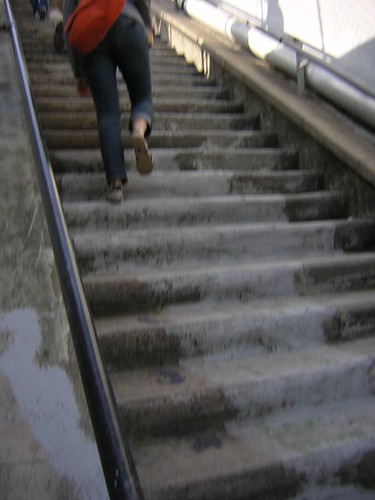
L’esprit d’escalier
Santa Cruz is a town of hills. Perhaps not as evocative as the hills of Rome, or the Ngong Hills of Kenya, the hills of Santa Cruz nonetheless add texture to the landscape. In Colorado, where I grew up, the streets of every small town are tree-lined—an urban forest. When I moved to Santa Cruz almost seventeen years ago, I was disturbed by the relative lack of trees. I felt exposed, like I was in a big parking lot. Over time, however, the hills and their texture came to replace trees for me as a symbol of location, a signifier of “place” over “space.” I began walking, taking long evening strolls, trying to find the places where I could look back and see the town stacked up in layers, with the Santa Cruz Mountains behind. Or places where, from a hill, I could look out across the bay and see the flat expanse interrupted by the other hills to the south, the Santa Lucia Mountains in Monterey County. Hills define neighborhoods (Beach Hill, Mission Hill) and isolated units (the City on the Hill). Walking from one hill to another is, thus, changing one’s scene, moving from one group of people to another.
On my jaunts I found the stairs. Unexpected and convenient for the walker, these stairs offered different ways to get around without using the often traffic-laden streets. Because the stairs are usually hidden from drivers, and because through conversation I found that many people did not know about them (or did not know about all of them), I started calling them “Super-Secret Staircases.” To wit: “I took the Super-Secret Staircase up from the Town Clock, then went down the one behind Squid Row.” These stairs seemed to come from a world and time when people walked more, and cars were driven less. I have imagined them peopled by the ghosts of Gibson girls, men with detachable collars, and toddlers of both sexes wearing skirts. As the walker leaves the streets, and takes the somehow tangential yet often more direct path of a stair, he or she enters a place of nostalgia and slow-down. Yet the exercise of hauling oneself up the risers makes the heartbeat and the breath come short, like in new love.
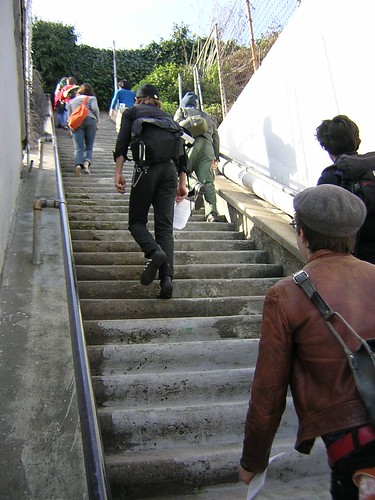
While walking these stairs, I have thought about the word “pedestrian.” Pedestrian means someone who walks; but it also can mean something unremarkable and dull—a pedestrian idea, a pedestrian piece of writing. Walking is not the same as whizzing by, and suggests the movement of “plodding along.” Yet these stairs, upon which one is a pedestrian, are not pedestrian in the other sense. Rather, they are vital and exciting, useful and direct. They cut through the excess of streets that, due to the constraints of horse-drawn or combustible engine-driven transport, must of necessity take a longer and more gradual route. They put the walker away from exhaust fumes and noise, and are, with their quiet and their views, contemplative. But they are “pedestrian” in the sense that they are also not evidently necessary: there are streets one could take instead, so why have a stair? To take the stair instead of the street is to experience both the use and uselessness of the footpath in an urban space where most people drive or ride bikes.
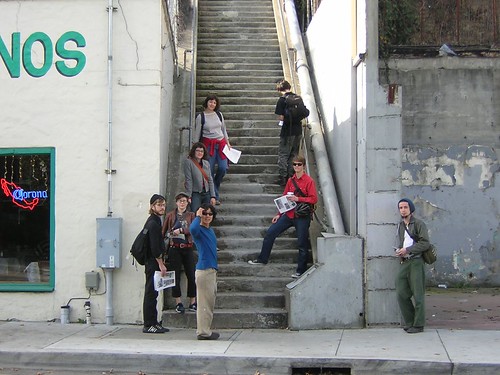
What, then, is the use of them? To walk on them, surely, but also not to walk on them—to drive past them and not know they are there. Ignorance of them creates another dimension, their “super-secretness,” which even those who do not know about them must nonetheless experience in their mental absence. Another aspect of these stairs is their bridging of the public and private. They are public—anyone can walk on them—and private (not everyone does). They are also “private” in a way that sidewalks generally are not, but that alleyways often are: they give view into the back sides of human habitation. On some of them, one goes by people’s side-yards, driveways, patios. Many of them, even though hidden from general view, are surprising clean, and not generally inhabited by drug-dealers, bottle-throwing drunks, or aggressive teen-agers, all of whom seem to favor the openness of places such as the sidewalk directly in front of my previous house. The stairs are, in effect, too clandestine for the fringe, who seem to want their activities to be noticed and abhorred more than hidden and ignored.
I first experienced the encapsulation of public and private on the multiple stairs that go down the side of Telegraph Hill in San Francisco, leading from Coit Tower to the Embarcadero. When I was twelve, visiting San Francisco on vacation, my father and I discovered these stairs, and I have always thought of that moment as the highlight of the trip. These stairs go through beautifully tended gardens that are owned by the city, but maintained by the residents of the hill. There, one gets the strong impression of walking through someone's backyard, an exhilarating and transgressive experience.
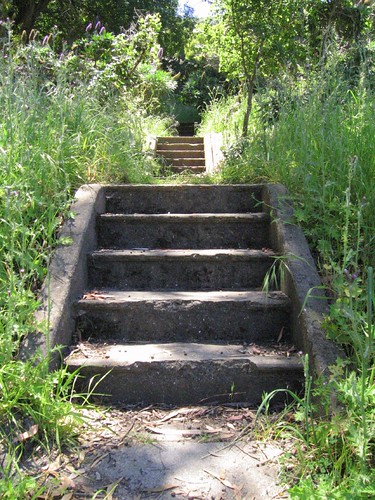
I have been told recently, by someone who knows construction terms, that the word "staircase" can only apply to stairs in a house or other structure. Outdoor versions are more correctly called simply "stairs." Therefore, my pet phrase, "Super-Secret Staircases," is a misnomer. I was dismayed for a while, thinking that, despite the nice ring of "Super-Secret Staircase," I might have to change my designation of these places. Then, in an act of recuperative imagination, I decided that for me these stairs are contained within a structure: my great outdoor house, the city of Santa Cruz in its entirety.
There is a phrase in French—"l’esprit d’escalier," the spirit of the stairway—that means, I am told, the sense of all the things you think you should have or might have said in an argument after the person you were arguing with has closed their door and you are walking down the stairs, leaving the scene. It has then, the feeling of regret, but also the awful cleverness of the post-facto reconstruction of a failed conversation. Remorse—which means literally “to eat again”—might be a better word than regret. In the spirit of the staircase we chew over our own words, spit them out, and replace them with ones far more piquant and savory. The esprit d'escalier is, for a remorseful person like myself, perhaps one of the chief attractions of the stairs. The existence of the stairs has, for me, continually begged the question: which failed conversation is the town of Santa Cruz itself reliving on its Super-Secret Staircases?
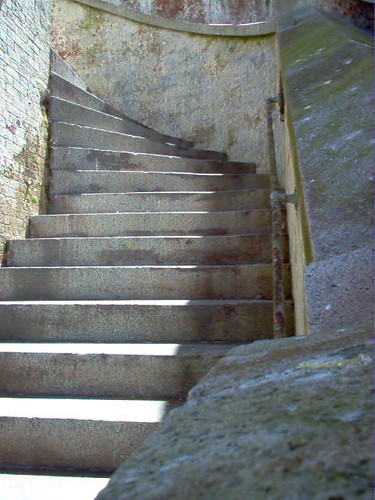



10 comments:
What a delight to read and food for thought. I've never given stairs or staircases much thought, except when I'm running up and down the ones in our house and I'm tired. We have tremendous "stairs" in Laguna Beach. In fact one beach is named "Thousand Step Beach" and it's got a couple hundred stairs, I think. It feels like it, we don't go there with our ice chest!
I find your writing very interesting and with insight that is different and fresh. Thanks Blaize!
graygoosie
Your photos are so intriguing. I have a thing for windows, and now I realize that staircases are just as interesting - where will they lead you? what will you find there? -kerry
It's funny, because I have a book on Stairway Walks in San Francisco that does much of the same stuff I do with my Super-Secret Staircase Tours. But, since San Francisco is hillier, and is a city, there are so many more stairs. Here, there is a limited amount, so it is easier to know the whole territory of stairways. I enjoy that my "knowledge" can be comprehensive here, which is an indication of why I am a "town girl", not a "city girl".
Great photos. Maybe someday I'll get to go on your tour. :)
Count me in as another who hopes to go on your tour someday. Your post did inspire me to check out the public staircase next to my house. It's definitely not super-secret, especially to the neighborhood gangbangers and taggers. But it has a strange charm, and will probably show up in my Flickr photos soon.
Those were my Super Secret Drinking Grounds as a teenager! Thank you for noticing their clandestine glory. When we sat on the little landing on the one by the Town Clock, clutching our 40oz secrets, we would always bring up the legend that the apartments at the top of the staircase were haunted. The legend was that the developer callously bulldozed a Native American burial ground, and the apartments he built were forever cursed.
I like the people in the pictures, in fact I know a few of them. I love Santa Cruz. and San Francisco.
Really enjoyed reading your blog and the photos are wonderful! I never realized about Santa Cruz although lived in San Francisco for years and they have their own hills and back stairs!
Lora
Blaize, Are you giving another public tour this Memorial Day 2008? I loved your last one and would like to bring friends
Yes, I will be giving the tour tomorrow. It starts at two o'clock, at the town clock. I hope to see you there!
Post a Comment